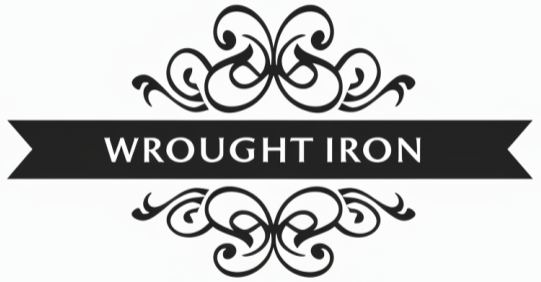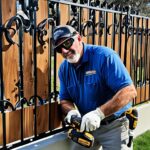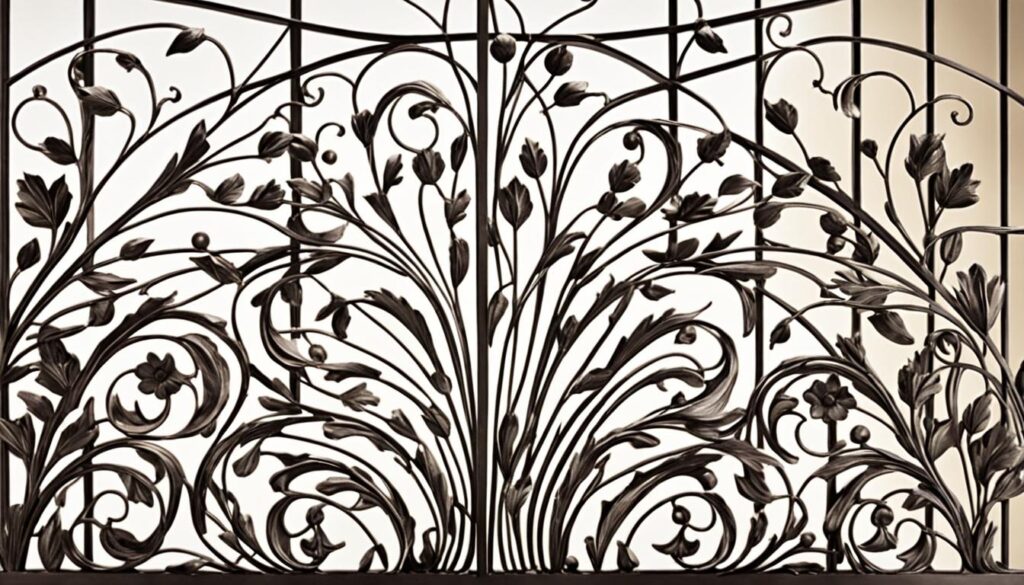
Have you ever wondered why wrought iron has stayed so popular for centuries? Known for its strength and flexibility, this metal has always been part of our progress. It began with early methods over 4000 years ago by the Hittites. Today, we see it in stunning modern designs1.
Wrought iron is unique because of its special fiber-like structure. This comes from the way it’s made, making it hard but also flexible. Plus, it fights off rust well, adding to its many uses. You’ll find it in things like elegant gates, detailed sculptures, and even furniture23.
Going beyond just construction, wrought iron is really important culturally and artistically. It has played big roles in history, like in weapons, and as beautiful decorations. It’s also part of famous places like the Eiffel Tower and Buckingham Palace’s gates3.
Key Takeaways
- Wrought iron’s low carbon content makes it softer and more malleable compared to steel2.
- This metal boasts a unique fibrous texture due to its siliceous impurities, adding to its corrosion resistance3.
- Wrought iron remains favored for architectural and decorative works, from historical gates to modern art pieces3.
- The cost of wrought iron is generally higher than basic steel, attributed to its niche market and the craftsmanship required2.
- Wrought iron’s historical and cultural significance continues to influence its use in both functional and ornamental applications today3.
What is Wrought Iron?
Wrought iron is a special kind of iron that has been used for centuries. It’s known for its strength, unique look, and feel. It stands out in the metal world because of these features.
Definition and Composition
Understanding wrought iron means knowing about its parts. It contains less than 1% carbon, with 0.02–0.03% being common4. There are also small amounts of sulfur, phosphorus, and silicon, about 0.25% total5. Mainly, it’s almost all iron, about 99.4%6. This makes it a very pure metal blend.
Wrought iron also has slag, from 1 to 4% of its makeup4. This slag helps give wrought iron its special look and structure.
Distinctive Characteristics
Wrought iron stands out because of its properties. It’s as strong as some modern steels, with a tensile strength of 300 MPa5. Its weight is about 7.74 g/m24, showing it’s very solid.
This iron doesn’t need much care, needing a new coat of paint every few years6. It’s easy to work with, perfect for making things like gates, fences, and railings. Its ability to change easily means it fits well in many places.
When thinking about wrought iron versus cast iron, remember the iron content. Cast iron has more carbon and silicon. This means it’s hard and can resist wear well5. But wrought iron is great for making look beautiful. It can be shaped easily and is often used for its artistic value.
The Historical Significance of Wrought Iron
The history of wrought iron is fascinating and spans from ancient times to the modern era. It began with ancient civilizations, evolved through the Middle Ages and Renaissance, and saw its peak in the Industrial Revolution.
Ancient Beginnings
In ancient times, civilizations like the Hittites and Mycenaean Greeks used wrought iron78. They crafted strong tools and weapons from it, showing early ironworking skills. This laid the foundation for the iron craftsmanship that came later.
Medieval and Renaissance Use
By 400 CE, wrought iron was not just for tools anymore. It started to be used decoratively in buildings7. Then, in Europe, it became a key part of famous buildings like Canterbury and Winchester Cathedrals8. The Renaissance period further popularized wrought iron for both its technical and artistic uses in architecture.
Industrial Revolution Advancements
The Industrial Revolution marked a major change for wrought iron in 1784 with the puddling furnace. This made production much easier and meant it could be used more in Great Britain8. By the 1860s, the United States was a big user of wrought iron, in buildings and making railways8. Yet, by the 1970s, mild steel had become the favored material because it was cheaper and simpler to make.
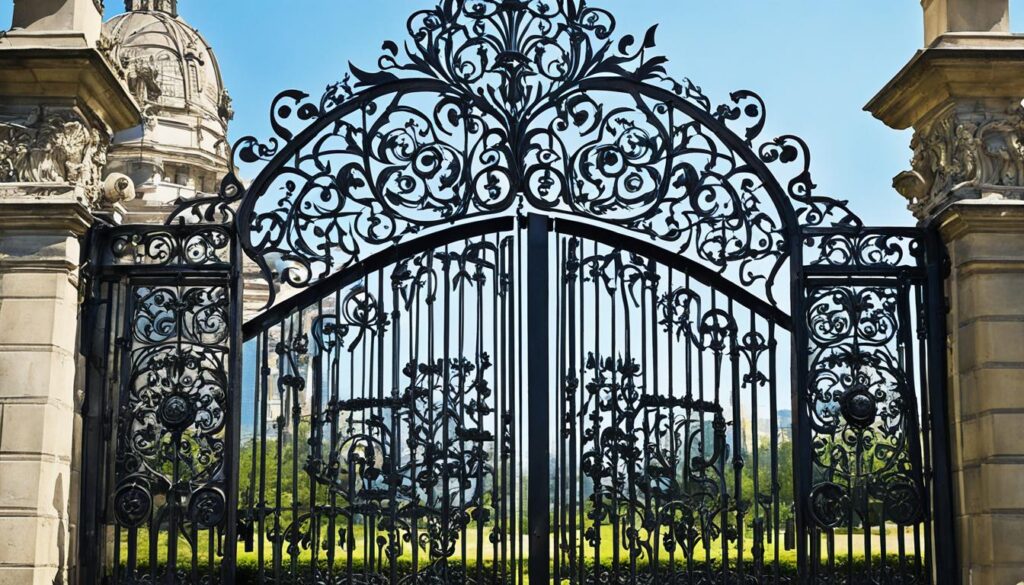
The Eiffel Tower, built between 1887 and 1889, is a prime example of wrought iron’s importance7. It played a big part during the Industrial Revolution. Even though steel took over later7, wrought iron remains key in the historical architecture of many structures around the world.
Wrought Iron vs. Cast Iron: Key Differences
The debate between wrought iron and cast iron often focuses on their unique traits and uses. Knowing these differences helps pick the right metal for different projects.
Carbon Content and Structure
Wrought iron mainly has pure iron with a bit of slag. This mix gives it a fibrous feel and less carbon9. It’s more bendable and tougher, which is great for a wide range of needs10. On the other hand, cast iron contains more carbon, around 2-4%. It also has manganese, silicon, sulfur, and phosphorus. This makes cast iron more brittle and not as flexible9.
Mechanical Properties
These metals have very different mechanical abilities. Wrought iron’s lower carbon level means it’s more ductile and malleable. It’s harder to break by hammering or stretching9. So, it’s a top choice for structures and decorations. Cast iron, with more carbon, is better for casting. It has strong compressive strength and holds up well against wear10. Yet, it can easily become brittle when hit9.
Applications
Wrought iron and cast iron each have their own important uses. Wrought iron is great for things like fences and railings. Its mix of strength and flexibility is perfect for these jobs10. Plus, it gets even stronger with each heat treatment9. In contrast, cast iron is key in heavy-duty products like cooking tools and car parts10
| Characteristic | Wrought Iron | Cast Iron |
|---|---|---|
| Carbon Content | Low | 2-4% |
| Structure | Fibrous, Elemental Iron with Slag | Carbon, Manganese, Silicon, Sulfur, Phosphorus |
| Mechanical Properties | High Ductility, Enhanced Malleability, Increased Strength10 | Brittle, High Compressive Strength, Good Wear Resistance10 |
| Common Applications | Fences, Gates, Railings, Decorative Elements10 | Cookware, Machinery, Automotive Parts10 |
Properties of Wrought Iron
Wrought iron is famous for being strong and lasting. It’s used in many ways because of its special features. By knowing what makes it stand out, we can see why it’s still loved today.
Ductility and Malleability
Wrought iron stands out for being easy to shape and change. It has very little carbon, less than 0.035%, so it’s flexible and can be made into fine details without losing strength11. This special iron has been a top choice for making art and buildings beautiful since ancient times, starting from Asia Minor in the 2nd millennium BC12.
Corrosion Resistance
Its unique look comes from the slag trapped in the iron. This not only looks interesting but also helps protect it from rust. That’s why wrought iron is perfect for things outside that face the weather, like fences and gates11. Even though it can still rust a little over time, it holds up much better than other metals. This means less upkeep for the things made from it, lasting a long time12.
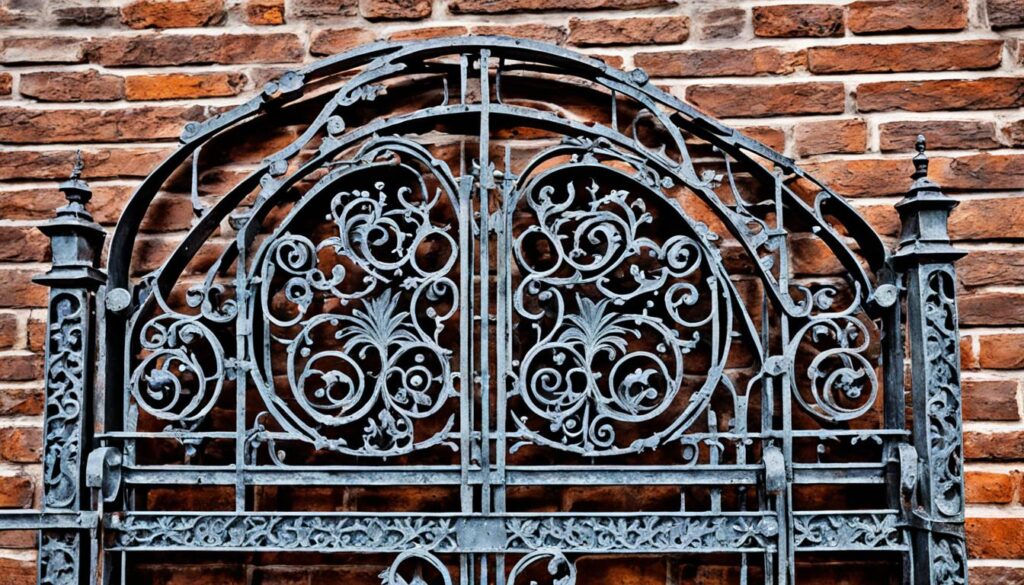
Toughness and Weldability
Wrought iron is both strong and easy to weld. Its sturdy design means it can handle a lot of pressure without breaking. This makes it good for making stuff look pretty or for big projects that need to last11. Being easy to weld also means it can be fixed or changed without too much trouble. It was very popular for buildings and objects in the 19th century. Then, new ways to make steel made it a bit less used, but it’s stilled loved for its unique qualities1112.
Common Uses of Wrought Iron
Wrought iron blends strength with flexibility, making it key in many areas. It’s used in building structures and creating art. Its special features make it great for looks and use.
Architectural Elements
Many structures use wrought iron for their looks and strength. For example, big gates and railings at fancy homes, and old balconies in towns. These show off its durability and beauty. The famed Eiffel Tower used 7,300 tons of it, showing how well it combines function and beauty13.
Decorative Arts and Sculpture
Wrought iron is also a top pick in art and decor. Artists like it for its ability to keep sharp details. It’s perfect for making ornate sculptures and lasting decor pieces14.
Furniture
Many love wrought iron furniture for its looks and durability. From bedframes to patio sets, its strength ensures long lifespans14. Its rust resistance means less upkeep, good for use indoors or out14.
Historical Restoration
Restoring old buildings often includes wrought iron. Its past use and lasting quality help keep history alive. It fights weather well and doesn’t need much care, making it perfect for saving historic looks and structures14.
The Manufacturing Process of Wrought Iron
Creating wrought iron is a detailed process. The steps give it special features. It all starts by changing iron ore into a workable form, ready for use.
Smelting
The first step is smelting. Iron ore is melted in a blast furnace to create pig iron. This is important as it turns hard cast iron into something soft and workable. Traditionally, heavy animals helped move the materials, showing the hard work it took15.
Puddling
After smelting, pig iron goes through puddling. This process is about making the iron better by removing carbon. It includes a technique of lifting the iron into hot air, a methodical step towards purifying it15. Puddling is key for getting rid of impurities like carbon, silicon, and manganese. This makes the wrought iron of high quality4.
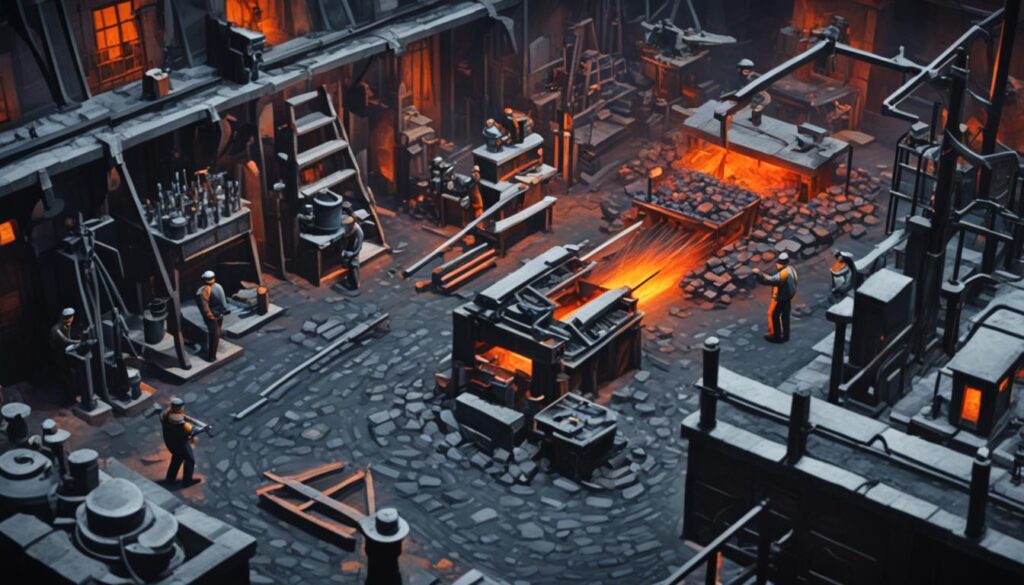
Shingling and Forging
Shingling comes next. Here the iron is hammered to make it cleaner. Workers use big hammers like a 500-pound helve-hammer15. This hammering not only cleans the iron but also changes its shape, welding and lengthening the iron crystals, with help from a flux called slag15. Skilled workers, known as hammermen, are crucial. They forge the iron bars carefully using a hammer and anvil.
After smelting, puddling, shingling, and forging, wrought iron is ready. It has unique qualities, perfect for a wide range of uses, from historical buildings to new architectural designs.
| Step | Description | Key Points |
|---|---|---|
| Smelting | Heating iron ore in a blast furnace to produce pig iron. | Conversion of brittle iron, involvement of heavy labor15 |
| Puddling | Stirring molten iron to reduce carbon content. | Elimination of impurities, repeated heating4 |
| Shingling | Hammering to remove impurities and shape the iron. | Use of heavy hammers, slag as flux15 |
| Forging | Shaping iron bars between the hammer and the anvil. | Skilled labor, precision in final product15 |
The Aesthetic Appeal of Wrought Iron in Modern Design
Modern wrought iron design is both attractive and meaningful. It mixes history with current style. This makes it an important part of today’s designs.
Architectural Accents
Wrought iron is making a comeback in architecture, linking the past with now16. It’s seen in simple designs on things like balconies and railings, blending old and new1617. The material can be shaped with fine detail, showing off many designs17. Its sturdy nature means it stays beautiful and strong for a long time17.
Outdoor Decor
Many outdoor designers choose wrought iron for its strength and versatility. It’s used in garden structures and outdoor furniture, making spaces beautiful16. People like colored designs and nature themes in their wrought iron, creating welcoming spots16. It’s also used for modern features, bringing something new to designs16. For those that care about the planet, wrought iron can now be made using recycled materials. This way, it’s both beautiful and earth-friendly16.
Modern Innovations in Wrought Iron Crafting
Wrought iron, containing less than 0.05% carbon18, is seeing new uses. Today, we will explore high-tech methods in wrought iron that are modernizing design and making.
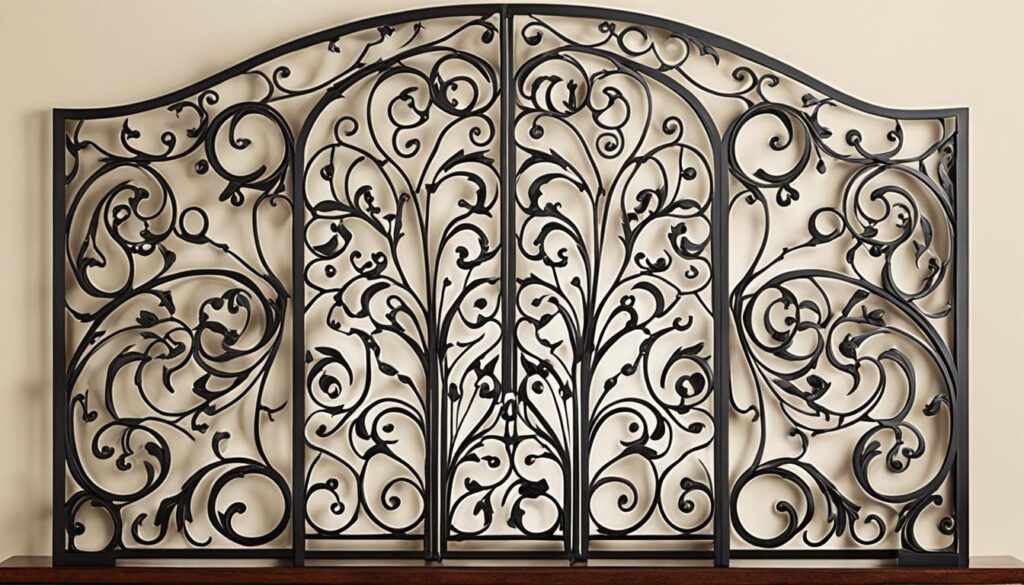
Recycled Wrought Iron
Recycling wrought iron is a top sustainable practice. It meets modern green goals and keeps this material useful19. In the past, wrought iron was key for tools, structures, and art19. Now, thanks to new crafting techniques, reusing and transforming old iron into fresh items is simpler and better than before.
Powder Coating
Powder coating boosts wrought iron’s lifespan, giving it a futuristic look. It fights off rust and damage over time19. This approach blends old techniques with new tech, redefining how we view and use ironwork.
Laser Cutting and CNC Machining
Laser cutting and CNC machining bring exceptional precision to wrought iron shaping. These methods allow for complex designs, enhancing the beauty and functionality of ironwork18. They’ve expanded the use of wrought iron in both eco-friendly and creative projects18. These sustainable practices highlight iron’s flexible nature and respect its history and appeal.
| Technique | Benefits | Applications |
|---|---|---|
| Recycled Wrought Iron | Eco-friendly, Cost-effective | Furniture, Structural Components, Decorative Arts |
| Powder Coating | Enhanced Durability, Corrosion Resistance | Outdoor Decor, Fences, Railings |
| Laser Cutting and CNC Machining | High Precision, Versatility | Architectural Elements, Artistic Creations |
By using these modern methods, wrought iron stays important for the future. It leads in green practices and innovation in crafting1918.
Comparing Wrought Iron and Steel
Wrought iron and steel are strong and durable. Steel is made of iron and carbon, making it stronger than wrought iron20. But, wrought iron is tough, with low carbon, suitable for gates and fancy work20. Steel shines in buildings and cars, while wrought iron is chosen for its looks in gates and art21.
Strength and Durability
Steel is tough because it blends with manganese, nickel, and copper to fit many needs21. Its wear-resistant types are perfect for places that scratch or hit a lot21. Wrought iron is good for both looking nice and standing strong under stress20.
Corrosion Resistance
Both steel and wrought iron have benefits against rust. Steel, especially with nickel and chromium, fights rust better than wrought iron20. Wrought iron resists rust but needs care to stay in good shape21.
Cost Considerations
Steel is usually cheaper than wrought iron. This is because making wrought iron takes more work thanks to its artisanal value and less carbon20. Steel is easier and quicker to make, dropping its price20. Thus, steel fencing is more budget-friendly. Wrought iron may cost more, but its classic look wins over those who value tradition.
FAQ
What is wrought iron?
How does wrought iron differ from cast iron?
What are some common uses of wrought iron?
Why is wrought iron favored in outdoor structures?
How has wrought iron changed through history?
What properties make wrought iron unique?
How is wrought iron manufactured?
What makes wrought iron aesthetically appealing in modern design?
What are the modern innovations in wrought iron crafting?
How does wrought iron compare to steel?
Source Links
- https://qpsl.com/wrought-iron-vs-cast-iron-key-differences-benefits/ – Wrought Iron vs Cast Iron: Key Differences & Benefits
- https://irishiron.com/blog/whats-the-difference-between-wrought-iron-and-metal-iron-or-steel/ – What’s the difference between wrought Iron vs steel? – Irish Iron
- https://irishiron.com/blog/what-is-rod-iron/ – What Is Rod Iron? – Irish Iron
- https://www.sciencedirect.com/topics/chemistry/wrought-iron – Wrought Iron – an overview
- https://www.metalsupermarkets.co.uk/wrought-vs-cast-iron-what-is-the-difference/ – Wrought vs Cast Iron: What is the difference? | Metal Supermarkets UK
- https://preciseirondoors.com/what-is-wrought-iron/ – What Is Wrought Iron? – Precise Iron Doors
- https://www.northlandfence.com/wrought-iron-history/ – The History of Wrought Iron Fencing – Northland Fence
- https://timelesswroughtiron.com/pages/history – History
- https://tampasteel.com/wrought-iron-vs-cast-iron/ – Wrought Iron vs Cast Iron: What’s the Difference? – Tampa Steel
- https://www.industrialmetalsupply.com/blog/difference-between-cast-and-wrought-iron – Industrial Metal Supply Company
- https://www.gsa.gov/real-estate/historic-preservation/historic-preservation-policy-tools/preservation-tools-resources/technical-procedures/wrought-iron-characteristics-uses-and-problems – Wrought Iron: Characteristics, Uses and Problems
- https://www.britannica.com/technology/wrought-iron – Wrought iron | Properties, Uses & History
- https://cacciolairon.com/industry/wrought-iron-vs-cast-iron-the-clash-of-the-metal-alloys/ – Wrought Iron vs Cast Iron: The Clash of the Metal Alloys – Cacciola Iron
- https://www.metalsupermarkets.com/wrought-vs-cast-iron-what-is-the-difference/ – Wrought vs Cast Iron: What is The Difference? | Metal Supermarkets
- https://www.nps.gov/articles/000/iron-making-refining-into-wrought-iron.htm – Iron Making: Refining into Wrought Iron (U.S. National Park Service)
- https://kingironworks.com/wrought-iron-design-trends/ – Wrought Iron Design Trends in 2024 – King Iron Works
- https://ironlionentries.com/the-timeless-elegance-and-lasting-benefits-of-wrought-iron-doors/ – The Timeless Elegance and Lasting Benefits of Wrought Iron Doors – Iron Lion
- https://en.wikipedia.org/wiki/Wrought_iron – Wrought iron
- https://qpsl.com/wrought-iron-a-timeless-craft/ – Wrought Iron: A Timeless Craft – QPSL
- https://arironllc.com/blog/steel-vs-wrought-iron-fencing/ – Steel vs. Wrought Iron Fencing | AR Iron Gates and Fencing
- https://titussteel.com/difference-between-steel-cast-iron-and-wrought-iron/ – Difference Between Steel, Cast Iron and Wrought Iron
